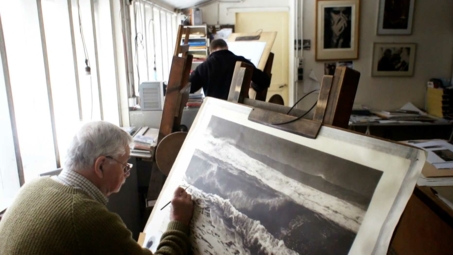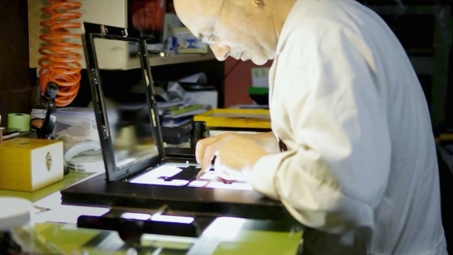The Printing in photography: An interview with Bernard Plossu
Bernard Plossu isn't usually very forthcoming. Each word reveals the coherence of a reasoned worldview, studded by aesthetic references. DK2R had the opportunity to ask him about printing, and his answers extend this central subject of the photographic act.
***
Emmanuel Bacquet: Bernard Plossu, what part does printing play in your photographic writing?
Bernard Plossu: If there's no print, there's no photo. That says it all! Of course printing is very important!
But what I seek is a kind of "discreet normalcy", certainly not a too-striking print that darkens the sky or highlights the drama! That would be the total opposite of what I'm trying to say (like cheesy film music that guides your emotions: it falls out of fashion so quickly)!
In black and white, subtle, soft greys, so as not to have an effect. (As Gauguin said: "Effects look good; they have an effect.") And in colour, the Fresson process, which is matte, allows me this same discretion of the printed image.
EB: Have you ever done your own prints?
BP: I did, learning alone in the bathroom, but I'm a lousy printer! I find old ones and they're OK, clean enough, but I gave that up when I returned from the Sahel; the light contrasts were too strong to print. So I gave up, and thanks to that, I was able to devote all my time to taking pictures, to photographic trips, to creating images. But when I send my negatives to be printed, I know exactly what I want to obtain.
Almost all American photographers print their own photos, whereas in Europe, the Doisneaus, Boubats and Henri Cartier-Bressons are all printed by their printers.
To me, the printer is my key co-worker, my soul brother; but for him, the photos wouldn't exist!
EB: You always work with the same printer, Guillaume Geneste, and in the case of your colour work, the Fresson workshop. How does your collaboration with a printer work? Do you often intervene? Do you like to be surprised?
BP: I've worked with Salaün, with Yvon le Marlec, and now in black and white with Françoise Nuñez at home, and with Guillaume Geneste for many years, my printer and great friend. In colour, with the Fresson family since 1967, and at one time with the late lamented Benny Karmazine. And now we're on our first tests with matt ink-jets! Watch this space...
By the way, in the film industry, the directors would film, but would never develop their films!
And their cameramen would never get as big a mention in the credits as directors and actors: Why not? It's unfair!
EB: How would you describe the aesthetic of the Fresson process?
BP: I don't know what to say about Fresson's aesthetic! As far as I'm concerned, for my photos, I'd say that what I like is matte and not glossy – not spectacular – discreet, saving the print's eloquence for what has been photographed.
EB: Your latest book, published by Textuel, is entitled "Tirages Fresson" (Fresson Prints). It's a nice tribute on your part, but the title also attests to the strong personality of the process (and of those who make it happen). Would you say that more than ever, your Fresson prints are a "four-handed" creation?
BP: Yes, working with Fresson is definitely a four-hander! The shot and its translation. I'd say that of any good printer!
EB: If the Fresson process didn't exist, how would you contemplate colour in your photographs?
BP: As I've worked with Fresson my entire professional life, I've never had to consider this question! At one point, for Kodak Stretch colour prints, I worked with Benny Karmazine: good matte prints, but without the Fresson grain! Now matte inkjet prints are the closest you get.
EB: Have you ever imagined the print in advance when you took the picture?
BP: Yes. Sometimes when I take a picture I think: that'll make a good Fresson. And even sometimes in front of a landscape that I'm not even photographing, I think: "What a beautiful Fresson that'd make."
EB: The Fresson print seems to have escaped the injunctions of the era of digital dematerialization, precision, immediacy, consumption... Is this a form of resistance?
BP: Yes, the Fresson print is an act of resistance. Well said! As is the choice to keep film as my language, or old cameras like my Nikkormats, which are half my age!
Fresson prints are made slowly, gently, respectfully, a world away from the unbearable fake happiness of smartphones and other digital devices that can take 600 photos: and for what? 36 is plenty for the intelligence of this language!
Bernard Plossu, December 2020
Translated from French by Mark Goodwin




